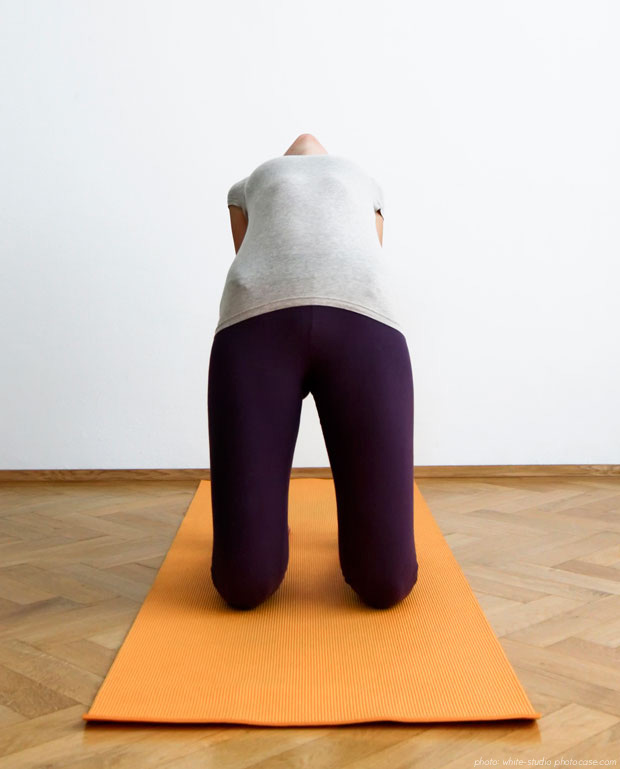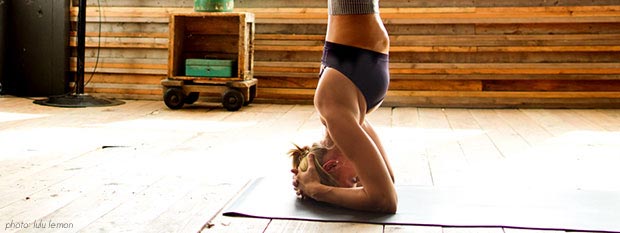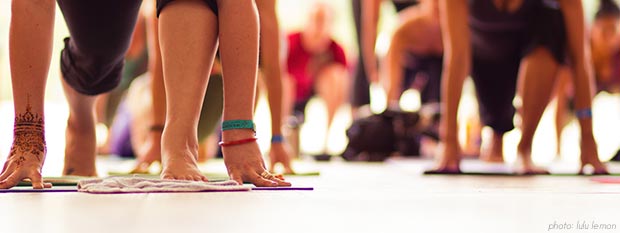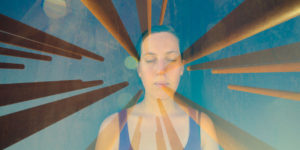Yoga For Your Ayurvedic Body Type
BY DAVID FRAWLEY & SANDRA KOZAK
According to the philosophy of Yoga, the physical body is a manifestation of consciousness. It is a crystallization of karmic (behavioral) patterns created by the mind. The key to working with the body through yoga, therefore, is to understand the consciousness behind it, much of which
lies outside our ordinary awareness. This requires that we practice asanas [yoga poses] aware not only of the technicalities of the postures, but also of the mental and emotional states that they create within us.Ayurveda shares this Yoga theory. It views the body as a manifestation of the doshas [personal constitution of mind, body and spirit], which are not merely physical but also pranic and psychological energies—factors of consciousness. We cannot look into the doshic impact of asanas purely on a physical level but must consider their psychological effects as well.
Yoga views asanas not merely as static poses but as conditions of energy, which in turn are manifestations of consciousness. The energy and attention that we put into the Yoga pose is as important as the pose itself. We can see this in ordinary life in which how we feel on a psychological level determines how we move on a physical level. Long-term patterns of feeling and energy determine the form and rhythm of the body.
Asana as Physical Structure
At the most basic level, an asana is a physical pose, a kind of bodily gesture. In yogic asana practice we place the body into a position that has a specific result and message depending upon the shape that it creates with the body. Each asana has its own structural effect. Sitting poses provide stability in the spine. Some of them create flexibility in the backs of the legs.
Since most sitting yogic postures create parasympathetic stimulation, they create a pleasant calming influence. Standing Yoga poses increase general strength and energy levels. Backbends tend to excite us (sympathetic stimulation), increase spinal extension, and create strength in the trunk elevator muscles. Relaxation poses even out and calm the energies created by our asana practice. All Yoga asanas, whether in groups or individually, have their own energetics depending upon what they do to the body. Like a house they have their own architecture.
However, since all our bodies do not have the same structure, the experience of an asana will vary depending upon the build, flexibility and organic condition of the individual. The effect of the asana is a combination of the structure of the asana, which is the same for everyone, and the person’s own bodily structure (also known as their Ayurvedic dosha), which will vary not only by individual, but also changes through the course of time, which Ayurveda recognizes and accounts for.
Asana as Pranic Energy
The physical body is a vehicle for our internal energies, which are defined through Prana [breath—life energy]. Asanas are vehicles through which Prana is directed. An asana is not merely a physical structure but a  condition of energy. Asanas express a quality of energy and even quieting Yoga poses can contain behind them a dynamic condition of mind and Prana. This fact gives all asanas a certain neutrality in their energetic effects, just as a vehicle in itself is neutral, with the goal of its travel depending on the driver. The asana is like a car with Prana as the driving force. It is not just a question of having the right vehicle, but also of moving it in the right way. The pranic impulse behind the asana is as important as the asana itself.
condition of energy. Asanas express a quality of energy and even quieting Yoga poses can contain behind them a dynamic condition of mind and Prana. This fact gives all asanas a certain neutrality in their energetic effects, just as a vehicle in itself is neutral, with the goal of its travel depending on the driver. The asana is like a car with Prana as the driving force. It is not just a question of having the right vehicle, but also of moving it in the right way. The pranic impulse behind the asana is as important as the asana itself.
This means that depending upon how we direct our Prana, the same asana can take us to different places. For example, a sitting Yoga posture done with strong pranayama can have a very energizing effect, while with ordinary breathing it will quiet us or even put us to sleep. The pranic energetics of an asana depend upon various factors including on how quickly we do the Yoga posture, the degree of force we use and, above all, on how we breathe during the asana. In fact, the goal of asana practice is to calm the body so that we can work on our Prana. Prana manifests when the body is still. This is the importance of sitting Yoga poses for internal healing.
Asana as Thought and Intention
Asana is not only structure and energy but also reflects thought and intention. We could call asana a ‘thoughtful’ or ‘mindful’ form of exercise. The effects of the same asana will vary depending upon whether our mind is clear or cloudy and our emotions are calm or turbulent. We may perform an asana with technical precision but our state of mind will determine how liberating the asana actually is for our consciousness.
Our mental state is reflected in our breath. When the mind is calm, the breath is calm. When the mind is disturbed, the breath is disturbed. So, mental and pranic energetics go together. While we can change the pranic effect of a Yoga pose through the breath, we can also change the mental effects of an asana through concentration and meditation. An asana should be a kind of meditation in form or movement. Therefore, we should always put our minds into a sacred space of silence, observation, and detachment while performing Yoga.
If our consciousness is not engaged during the asana, then our practice remains at a superficial level. Prana follows the energy of attention. The bodily posture is an outcome of that. The kind of posture that a person has reflects how they place their attention in life, what they most commonly do. That is why so many of us are hunched over today. Our main posture is sitting at a desk, in a car, or on a couch! This places our energy outside ourselves and so our internal energy sinks or collapses.
In summary, therefore, the structural effect of the asana is the first factor. The way we energize the asana through Prana is the second. This includes how we move through the asana and breathe within it. Our state of mind is a third factor. The main rule in Yoga practice is to keep the mind calm, collected and attentive so that we don’t lose focus in the practice. We must consider all three factors relative to an ayurvedic examination of asanas. All these factors are interrelated. The ayurvedic dosha often contains the key to the structural, pranic and emotional state of a person.
Ayurvedic Effects of Asanas
Each asana has a particular effect defined relative to the three ayurvedic doshas. This is the same as how Ayurveda classifies foods according to their doshic effects as good or bad for Vata, Pitta and Kapha, depending upon the tastes and the elements that compose each food article. We can look upon different Yoga asanas according to their structural ability to increase or decrease the doshas.
However, this doshic equation of asanas should not be taken rigidly because the pranic effect of an asana can outweigh its structural effect as we just noted. The form of the asana is not its main factor. Through the use of the breath we can modify or even change the doshic effects of the asana. We must remember the importance of thought and intention in asana practice as well. Considering the asana, Prana and the mind, we can alter a particular asana or adjust the entire practice toward a particular doshic result. Through combining specific asanas, pranayama and meditation a complete internal balance can be created and sustained.Don’t Know Your Ayurvedic Dosha?
Take the Chopra Center Ayurvedic Dosha test and find out now
[/impact_text]
Doshic application of asanas is twofold.
Constitutional Application
Vata types have a different bodily structure and move in a different way than do Pitta or Kapha types. Similarly, Pittas and Kaphas have their own particular movements and postures that they assume as part of the doshic signature on their bodies and minds. This difference between the doshas is reflected in the pulse of each type.
[one_third_last]Kapha types have a pulse like a swan that is broad and flowing. They move like a swan—slow, stately and elegant, taking their time in an undulating manner. Their energy flows like a slow, meandering river, taking its time along the way, assured of its ultimate goal. Yet when Kapha accumulates, their movement resembles water flowing through a marshland, with resistance and leading to stagnation. Their internal energy and thoughts have the same watery movement and possible inertia.[/one_third_last]
Each doshic type has its own particular structure and energy of life that extends to asana practice. Asana practice must consider the ayurvedic dosha of the person to be really effective.
[one_third_last]Kapha energy is resistant and complacent. It must be moved and stimulated by degrees, like ice that must be slowly melted until it can flow smoothly. We must consistently energize and stimulate the Kapha type to further action.[/one_third_last]
However, that an asana may not be good for a particular doshic type doesn’t mean that they should never do it. It means they should practice the Yoga asana in a way that guards against any potential imbalances. Take, for example, backbends. Forceful or quickly done full backbends can cause major Vata aggravation, with severe strain to the nervous system perhaps more so than any other asana. However, gentle partial backbends are great for reducing Vata that accumulates in the upper back and shoulders.
Each asana family, like standing Yoga poses, forward bends, or inverted postures, has general benefits for the body as a whole and its overall movement potential. Each asana family exercises certain muscles and organs that, as part of our entire bodily structure, should not be neglected. To counter any tendencies toward imbalance, you should select Yoga poses within each asana family that are better for your body type than others within the same group. In general, you should make sure that all the main muscle groups in the body are represented in your Yoga practice at least several days each week.
Similarly, that an asana is good for a particular dosha doesn’t mean all persons of that doshic type should do it. It means that the asana can be good for them if done in the right way and if they are physically capable of it. Each asana also has its degree of difficulty that may require certain warm up or preparatory Yoga postures to approach it safely. For example, the right preparation for a headstand creates the arm and shoulder musculature needed to sustain a good and safe head balance. Because a headstand is good for your doshic type doesn’t mean that you should simply jump into the posture or can do it without possible side effects.
In addition, the effects of different Yoga asanas vary according to the sequence in which they are done. This means that asana practice should always be viewed as a whole—not merely in terms of the single asanas that compose it, but in terms of the flow and the relationship between all the particular asanas done. Asana practice—meaning the sequence and manner of doing asana as well as the specific asanas—should be designed to keep the doshas in balance relative to the individual’s constitution and condition.
It is helpful to view asana sequence like an herbal formula. An ayurvedic herbal formula contains a number of herbs used for various purposes that contribute to the overall effect of the formula, fulfilling specific roles. The overall doshic effect of the formula is determined by the formula as a whole, not by any single herb within it viewed in isolation. Combining these ayurvedic considerations with the general factors listed above, to effectively prescribe asanas teachers must learn to:[one_fourth]Assess the mental state of the person, their attention, will and motivation, as well as their emotional condition.[/one_fourth]
[one_fourth]Assess the structural condition of the person, including their posture, age and physical condition.[/one_fourth]
[one_fourth]Assess their pranic condition, their control of the breath and senses, along with their vitality and enthusiasm.[/one_fourth]
[one_fourth_last]Assess the ayurvedic type and imbalances of the person.[/one_fourth_last]
The same Yoga asana should be done differently relative to whether the person is Vata, Pitta or Kapha. The same asana should be done differently depending upon the age, sex and physical condition of the person. It should vary depending upon whether the person has a strong or weak vitality. Additional variations will occur if a person is suffering from anger, grief, stress or depression. This reflects four primary goals for an ayurvedic asana practice.
[one_fourth]1. To improve the structural condition of the body[/one_fourth]
[one_fourth]2. To facilitate the movement and development of prana[/one_fourth]
[one_fourth]3. To calm and energize the mind[/one_fourth]
[one_fourth_last]4. To balance the doshas[/one_fourth_last]
Ayurvedic Body Types and Asana Practice
To understand the asana potentials of different people we will want to look at them according to their doshic body types.
Vata Dosha
Vata types have thin and long bones that are often weak or brittle. They have low body weight and poor development of the muscles, but a good deal of speed and flexibility. Their bone structure makes them good at bending and stretching, particularly of the arms and legs, when they are young. As they get older, however, the dry quality of Vata increases and causes them to lose mobility if they don’t exercise regularly.
A gentle, slow asana practice evenly balanced on both sides of the body is the ideal exercise for Vata types. Vatas are most in need of asana practice because asana alleviates accumulated Vata from the back and the bones, where it easily gets lodged. Vata diseases begin with an accumulation of the downward moving air (Apana Vayu) in the colon, which gets transferred to the bones, where it causes bone and joint problems. Vata benefits from the massaging action of Yoga asana on the muscles and joints, which releases nervous tension and balances out the system.
Negative Potential of Vata Dosha
Vata types more commonly suffer from stiffness owing to dryness and deficiency in the tissues. Their lack of body weight does not allow for adequate cushioning of the joints and nerves or proper hydration of the tissues. They are more prone to injury because they like to initiate sudden and abrupt movements, as well as going to extremes in their practice.
Positive Potential of Vata Dosha
Vata types like movement and exercise. They prefer to be active and expressive both physically and mentally and like to do new things. Asana is something that they easily take to and grow accustomed to as part of their active nature. It is a soothing way for them to exercise.
Blocked and Deficient Vata Dosha
There are two basic conditions of Vata, what are called blocked Vata or deficient Vata. Blocked Vata exhibits a stuck energy somewhere in the body, along with pain or discomfort but otherwise normal body weight. Deficient Vata exhibits low energy, low body weight and hypersensitivity, often without any acute pain. Blocked Vata requires movement-oriented or pranic asanas to release it. Deficient Vata requires a gentle and building approach, avoiding strong exertion. Blocked Vata is more common in young people who have adequate energy but get it blocked, while deficient Vata is more common in the elderly whose tissue quality is in decline.
Keys to Practicing Yoga for Vata Types
[one_fourth]Keep your energy firm, even and consistent; moderate and sustain your enthusiasm[/one_fourth]
[one_fourth]Keep the body calm, centered and relaxed; do the asana slowly, gently and without undue or sudden use of force; avoid abrupt movements[/one_fourth]
[one_fourth]Keep the breath deep, calm and strong,emphasizing inhalation[/one_fourth]
[one_fourth_last]Keep the mind calm and concentrated, grounded in the present moment[/one_fourth_last]
Pitta Dosha
Pitta types have an average build with a generally good development of the muscles and a looseness of the joints, which gives them a fair amount of flexibility. They are good at asana practice but cannot do some of the more exotic poses that Vatas can do because of the shorter bones that they usually have. Pittas benefit from asana practice to cool down the head, cool the blood, calm the heart and relieve tension. For example, Pittas tend to hypertension because of their fiery temperament that keeps them always wanting to succeed or to win.
Negative Potential of Pitta Dosha
Pitta types tend to be overheated and irritable owing to excess internal heat. They may lack the patience to get started in practice or to stick with it over time. On the other hand, once involved they can overdo postures and be aggressive and militant in their Yoga practice. A Pitta who has pushed too hard in their Yoga practice will feel more irritable or even angry after they finish. Pittas also will tend to stick with poses that they can do well and ignore those that may help them develop further.
Positive Potential of Pitta Dosha
Pittas have the best focus and determination of the doshic types. They easily get into a consistent discipline and determined practice once they have gotten it started and oriented correctly. They are the most orderly and consistent of the types. They just have to discover the right path to place their energies.
Keys to Practicing Yoga for Pitta Types
[one_fourth]Keep your energy cool, open and receptive, like the newly waxing Moon[/one_fourth]
[one_fourth]Keep the body cool and relaxed; do the asanas in a surrendering manner to remove heat and tension[/one_fourth]
[one_fourth]Keep the breath cool, relaxed and diffused; exhale through the mouth to relieve heat as needed[/one_fourth]
[one_fourth_last]Keep the mind receptive, detached and aware but not sharp or critical[/one_fourth_last]
Kapha Dosha
Kaphas are typically short and stocky, gaining weight easily. With their short and thick bones they lack flexibility and cannot do Yoga poses that require flexibility like the lotus pose. Yet they are sturdy and strong and have the best endurance of the different types. Kaphas need movement and stimulation to counter their tendency to complacency and inertia. They are good at keeping a practice going for longer periods of time, once they get it going in the first place.
Negative Potential of Kapha Dosha
Kaphas tend to be overweight, which limits their movement and makes them sedentary. They often have congestion in the lungs that makes deep breathing difficult. They lack in positive effort and find it hard to change with out some sort of external stimulation. They need to be constantly prodded to do more or they will stop short in their efforts.
Positive Potential of Kapha Dosha
Kaphas are steady and consistent in what they do. Once they take something up they do it faithfully over time. They remain emotionally calm and even in their Yoga practice regardless of the results. They view life with love and work as a service.
Keys to Practicing Yoga for Kapha Types
[one_fourth]Make sure to warm up properly and then do the asana with effort, speed and determination[/one_fourth]
[one_fourth]Keep the body light and moving, warm and dry[/one_fourth]
[one_fourth]Keep the Prana upward moving and circulating; take deep, rapid breaths if necessary to maintain energy[/one_fourth]
[one_fourth_last]Keep the mind enthusiastic, wakeful and focused like a flame[/one_fourth_last]
The Ayurvedic Way of Performing Yoga Asanas
Ayurveda does not look upon Yoga asanas as fixed forms that by themselves either decrease or increase the doshas. It views them as vehicles for energy that can be used to help balance the doshas, if used correctly. The same is true of the ayurvedic view of food. While individual food items have their specific effects to increase or decrease the doshas, how we prepare the food, how we antidote it with spices, how we combine it, or how we cook it to blend food qualities into a harmonious whole, is as significant as the particular foods themselves.
While Ayurveda says that foods of certain tastes are more likely to increase or decrease specific doshas, it also says that we need some degree of all the tastes. So, too, we need to do all the major types of Yoga asanas to some degree. It is the degree and exertion that varies with the doshic type. Each person requires a full range of exercise that deals with the full range of motion in the body.
Your overall Yoga asana practice should be like a meal. Each meal should contain some degree of all six tastes (sweet, sour, salty, pungent, bitter and astringent) and some amount of all nutrient types required for the body (starches, sugars, proteins, oils, vitamins and minerals) but adjusted to the needs of individual ayurvedic constitution. So too, asana practice should contain all the main types of Yoga asanas necessary for exercising and relaxing the entire body, adjusted to individual constitutional factors. It should include sitting, standing and prone postures, expansive, contractive, ascending and descending movements, but in a manner and sequence that keeps us in balance and considers our individual structural, energetic and mental conditions.
This article on yoga for your ayurvedic body type is excerpted with permission from Yoga for your Type: An Ayurvedic Approach to Your Asana Practice by David Frawley and Sandra Summerfield Kozak.
About The Authors

David Frawley is a teacher and author of more than 30 books which focus on Yoga philosophy, Ayurveda, and Vedic astrology. He is the Founder of the American Institute of Vedic Studies and a Master Chopra Center Educator. Visit: vedanet.com

Sandra Summerfield Kozak, M.S., is an internationally celebrated yoga teacher who has been studying and teaching yoga for 40 years. In addition to her work as an author and an artist, she is also the Founding Director of International Yoga Studies. Visit her website: sandrakozak.com


























